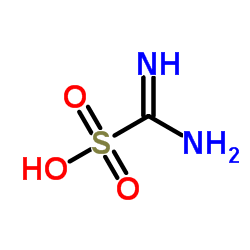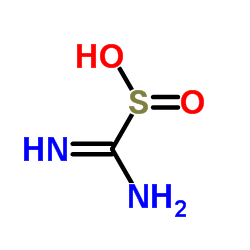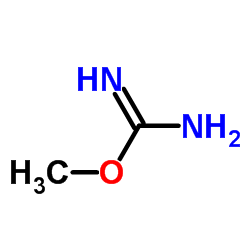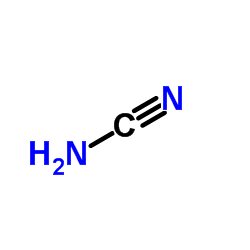胍基丙酸
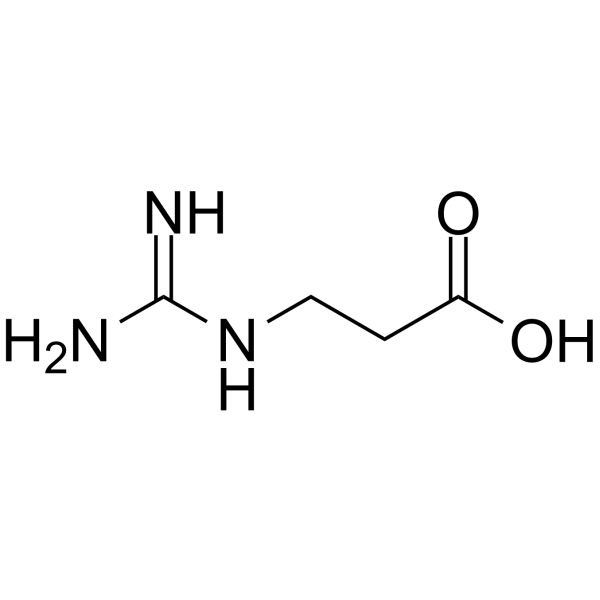
胍基丙酸结构式

|
常用名 | 胍基丙酸 | 英文名 | RGX-202 |
|---|---|---|---|---|
| CAS号 | 353-09-3 | 分子量 | 131.133 | |
| 密度 | 1.5±0.1 g/cm3 | 沸点 | 299.1±42.0 °C at 760 mmHg | |
| 分子式 | C4H9N3O2 | 熔点 | 222 °C (dec.)(lit.) | |
| MSDS | 中文版 美版 | 闪点 | 134.7±27.9 °C | |
| 符号 |

GHS07 |
信号词 | Warning |
胍基丙酸用途RGX-202是一种口服小分子SLC6A8转运体抑制剂。RGX-202在体外和体内强烈抑制肌酸输入,降低细胞内磷酸肌酸和ATP水平,并诱导肿瘤细胞凋亡。RGX-202可用于癌症研究[1]。 |
| 中文名 | beta-丙酸胍 |
|---|---|
| 英文名 | 3-guanidinopropanoic acid |
| 中文别名 | 胍基丙酸 |
| 英文别名 | 更多 |
| 描述 | RGX-202是一种口服小分子SLC6A8转运体抑制剂。RGX-202在体外和体内强烈抑制肌酸输入,降低细胞内磷酸肌酸和ATP水平,并诱导肿瘤细胞凋亡。RGX-202可用于癌症研究[1]。 |
|---|---|
| 相关类别 | |
| 靶点 |
Human Endogenous Metabolite |
| 体外研究 | RGX-202(10μM;96小时)可减少细胞生长,并显示出磷酸肌酸几乎完全耗尽(>99%),细胞内肌酸减少超过79%,细胞内ATP水平相对于缺氧时的对照细胞显著降低(46%)[1]。 |
| 体内研究 | RGX-202(800 mg/kg;p.o.35天)降低B6129SF1/J小鼠的UN-KPC-961胰腺肿瘤肌酸水平[1]。RGX-202(约650 mg/kg;连续14天每天腹腔注射)治疗可将NOD-SCID小鼠的Lvm3b细胞肝转移定植减少八倍[1]。动物模型:UN-KPC-961胰腺肿瘤B6129SF1/J小鼠[1]剂量:800 mg/kg给药:p.o.持续35天结果:在800 mg/kg剂量下,肿瘤d3肌酸进口抑制50%。动物模型:6至9周龄C57BL/6J雄性野生型小鼠[1]剂量:100、250、500 mg/KG无菌0.9%氯化钠给药:p.o.持续35天结果:在500 mg/KG剂量下,以剂量依赖性方式抑制组织对d3肌酸的摄取高达75%。 |
| 参考文献 |
| 密度 | 1.5±0.1 g/cm3 |
|---|---|
| 沸点 | 299.1±42.0 °C at 760 mmHg |
| 熔点 | 222 °C (dec.)(lit.) |
| 分子式 | C4H9N3O2 |
| 分子量 | 131.133 |
| 闪点 | 134.7±27.9 °C |
| 精确质量 | 131.069473 |
| PSA | 99.20000 |
| LogP | -1.68 |
| InChIKey | KMXXSJLYVJEBHI-UHFFFAOYSA-N |
| SMILES | NC(N)=NCCC(=O)O |
| 外观性状 | 白色结晶粉末 |
| 蒸汽压 | 0.0±1.3 mmHg at 25°C |
| 折射率 | 1.575 |
| 储存条件 | −20°C |
| 分子结构 | 1、 摩尔折射率:29.56 2、 摩尔体积(m3/mol):89.5 3、 等张比容(90.2K):254.1 4、 表面张力(dyne/cm):65.0 5、 极化率(10 -24cm 3):11.71 |
| 计算化学 | 1.疏水参数计算参考值(XlogP):-1.8 2.氢键供体数量:3 3.氢键受体数量:3 4.可旋转化学键数量:3 5.互变异构体数量:2 6.拓扑分子极性表面积102 7.重原子数量:9 8.表面电荷:0 9.复杂度:128 10.同位素原子数量:0 11.确定原子立构中心数量:0 12.不确定原子立构中心数量:0 13.确定化学键立构中心数量:0 14.不确定化学键立构中心数量:0 15.共价键单元数量:1 |
| 更多 | 一、物性数据 性状:不可用 密度(g/mL,25/4℃):不可用 相对蒸汽密度(g/mL,空气=1):不可用 熔点(ºC):222 沸点(ºC,常压):不可用 沸点(ºC,5.2kPa):不可用 折射率:不可用 闪点(ºC):不可用 比旋光度(º):不可用 自燃点或引燃温度(ºC):不可用 蒸气压(kPa,25ºC):不可用 饱和蒸气压(kPa,60ºC):不可用 燃烧热(KJ/mol):不可用 临界温度(ºC):不可用 临界压力(KPa):不可用 油水(辛醇/水)分配系数的对数值:不可用 爆炸上限(%,V/V):不可用 爆炸下限(%,V/V):不可用 溶解性:不可用 |
| 符号 |

GHS07 |
|---|---|
| 信号词 | Warning |
| 危害声明 | H315-H319-H335 |
| 警示性声明 | P261-P305 + P351 + P338 |
| 个人防护装备 | dust mask type N95 (US);Eyeshields;Gloves |
| 危害码 (欧洲) | Xi:Irritant; |
| 风险声明 (欧洲) | R36/37/38 |
| 安全声明 (欧洲) | S26-S36 |
| 危险品运输编码 | NONH for all modes of transport |
| WGK德国 | 3 |
| RTECS号 | AY3157500 |
| 海关编码 | 2925290090 |
|
~75% 
胍基丙酸 353-09-3 |
| 文献:Synthesis, , # 9 p. 777 - 779 |
|
~74% 
胍基丙酸 353-09-3 |
| 文献:Synthesis, , # 12 p. 1656 - 1658 |
|
~% 
胍基丙酸 353-09-3 |
| 文献:Journal of Molecular Biology, , vol. 396, # 4 p. 870 - 882 |
|
~% 
胍基丙酸 353-09-3 |
| 文献:Bulletin de la Societe Chimique de France, , p. 182 |
|
~% 
胍基丙酸 353-09-3 |
| 文献:Zhurnal Obshchei Khimii, , vol. 18, p. 2028 Chem.Abstr., , p. 3793 |
|
~% 
胍基丙酸 353-09-3 |
| 文献:Chemische Berichte, , vol. 8, p. 1263 |
|
~51% 
胍基丙酸 353-09-3 |
| 文献:Tetrahedron Letters, , vol. 43, # 8 p. 1401 - 1403 |
| 海关编码 | 2925290090 |
|---|---|
| 中文概述 | 2925290090 其他亚胺及其衍生物,以及它们的盐。监管条件:无。增值税率:17.0%。退税率:9.0%。最惠国关税:6.5%。普通关税:30.0% |
| 申报要素 | 品名, 成分含量, 用途 |
| Summary | 2925290090 other imines and their derivatives; salts thereof。Supervision conditions:None。VAT:17.0%。Tax rebate rate:9.0%。MFN tariff:6.5%。General tariff:30.0% |
|
Novel parent structures for inhibitors of the murine GABA transporters mGAT3 and mGAT4.
Eur. J. Pharmacol. 519(1-2) , 43-7, (2005) Searching for potent and subtype selective parent structures of the murine gamma-aminobutyric acid (GABA) transporter subtypes mGAT3 and mGAT4 a series of amino acids was characterised in a uniform [3... |
|
|
Three-dimensional quantitative structure-activity relationship analyses of substrates of the human proton-coupled amino acid transporter 1 (hPAT1).
Bioorg. Med. Chem. 19 , 6409-18, (2011) The proton-coupled amino acid transporter hPAT1 has recently gained much interest due to its ability to transport small drugs thereby allowing their oral administration. A three-dimensional quantitati... |
|
|
Accumulation of methylguanidine and changes in guanidino compound levels in plasma, urine, and kidneys of furosemide-treated rats.
Metab. Clin. Exp. 57(6) , 802-10, (2008) Antidiuresis and renal diseases alter the levels of guanidino compounds (GCs) in various tissues. Therefore, we hypothesized that diuresis could also disturb GC metabolism, storage, and elimination. I... |
| EINECS 206-530-0 |
| β-Alanine, N-(aminoiminomethyl)- |
| 3-(diaminomethylideneamino)propanoic acid |
| n-carbamimidoyl-|A-alanine |
| beta-Guanidinopropionic acid |
| 3-Guanidinopropanoate |
| 3-carbamimidamidopropanoic acid |
| N-Carbamimidoyl-β-alanine |
| N-(Aminomethyl)-β-alanine |
| MFCD00045939 |
| Guanidinopropionic acid |
| 3-Guanidinopropionic Acid |
| β-Guanidinopropionic acid |
| b-Guanidinopropionate |
| 3-Guanidinopropanoic acid |
| 3-guanidinepropionic acid |

